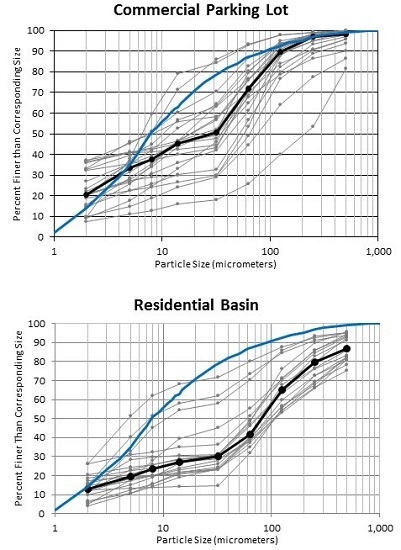The Effect of Particle Size Distribution on the Design of Urban Stormwater Control Measures
Abstract
:1. Introduction
2. Materials and Methods
2.1. Site Description
2.1.1. Commercial Parking Lot
2.1.2. Residential Basin
2.2. Development of PSDs
2.2.1. The Nationwide Urban Runoff Program
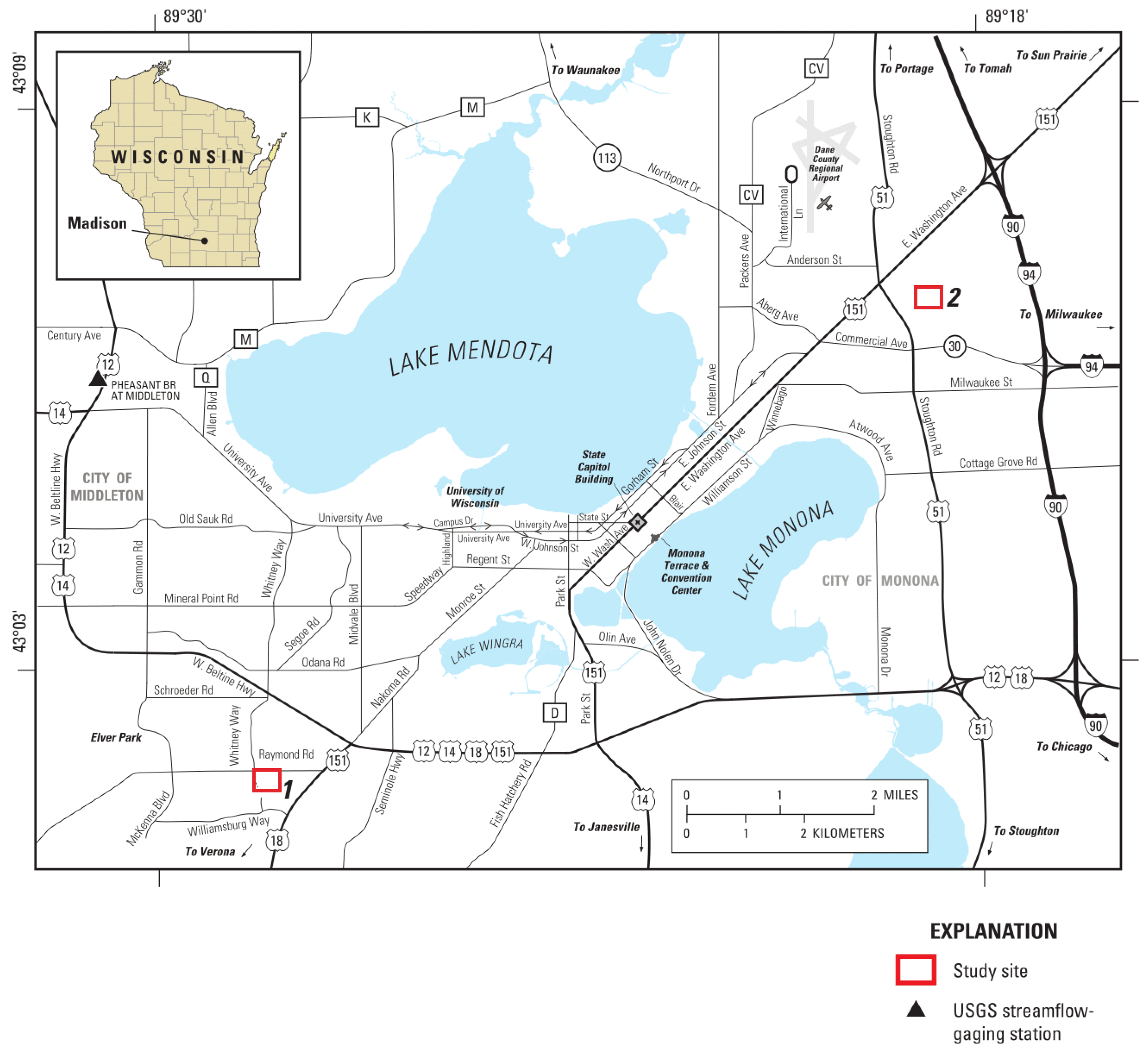

2.2.2. Measured Distributions Using Improved Sample Collection Technology
| Study Site | Spring (April–May) | Summer (June–August) | Fall (September–October) |
|---|---|---|---|
| Commercial Parking Lot | 6 | 9 | 5 |
| Residential Basin | 8 | 8 | 3 |
2.2.3. Predicted Seasonal Distributions Using Regression Techniques
2.3. Model Development
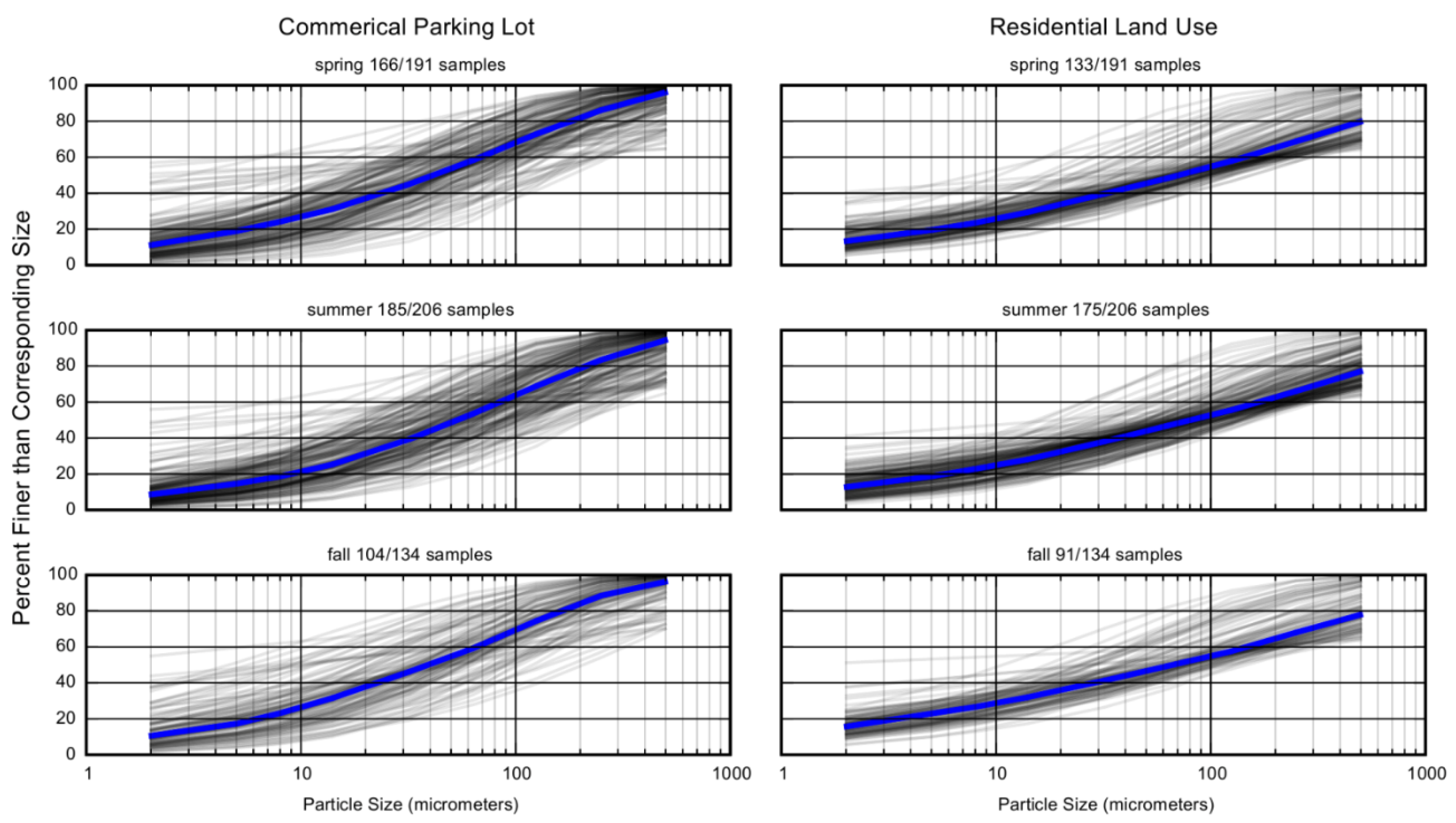
2.3.1. Wet Pond Design
2.3.2. Catch Basin Design
3. Results and Discussion
3.1. Differences in Particle Size Distribution
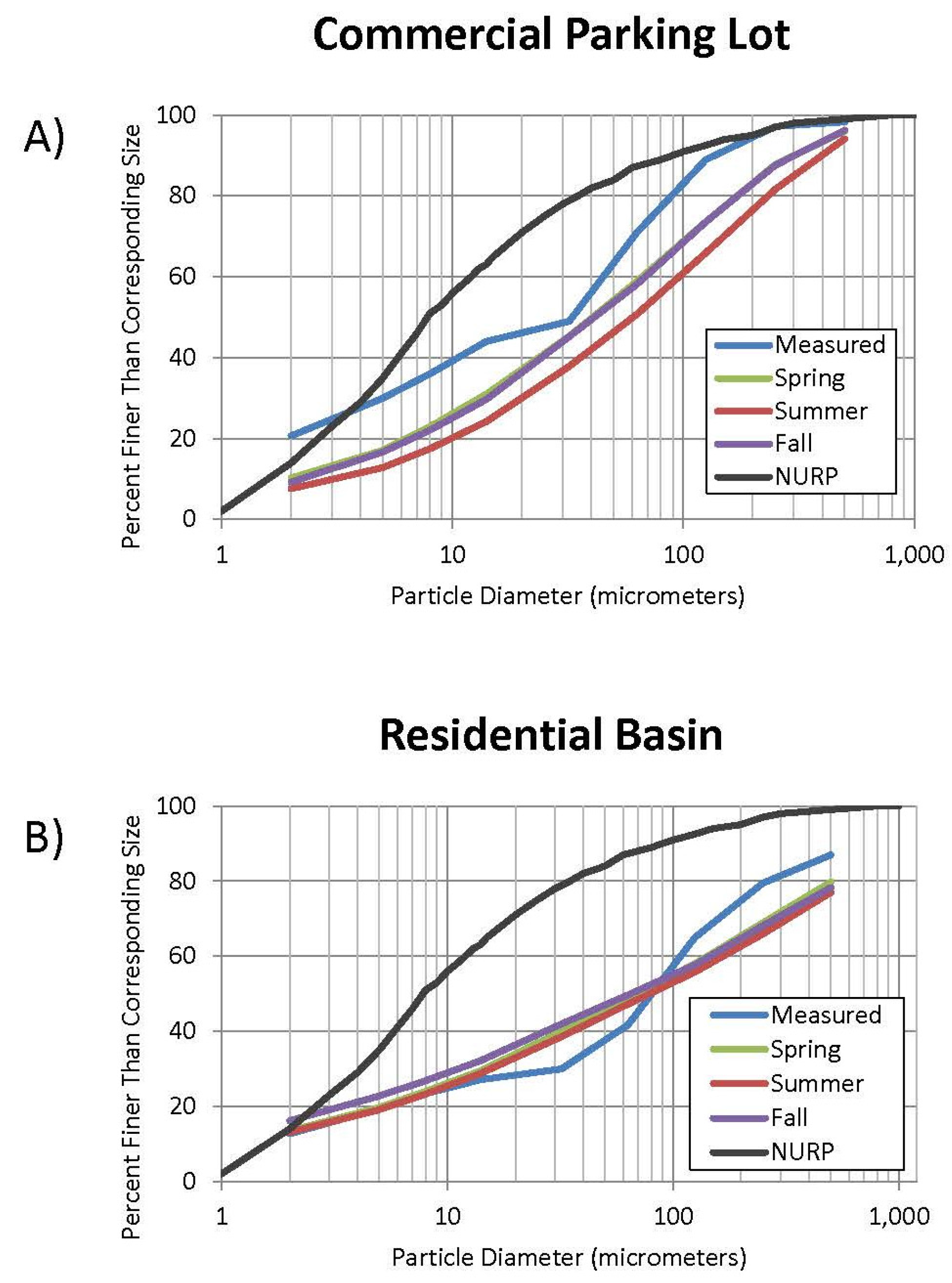
| Percent Control | NURP | Commercial Parking Lot | Residential Basin | ||||||
|---|---|---|---|---|---|---|---|---|---|
| Measured | Spring | Summer | Fall | Measured | Spring | Summer | Fall | ||
| 80 | 3 | 2 | 7 | 10 | 7 | 6 | 5 | 6 | 4 |
| 60 | 6 | 11 | 23 | 35 | 25 | 53 | 30 | 33 | 25 |
| 40 | 12 | 40 | 65 | 94 | 70 | 100 | 150 | 170 | 150 |
| 20 | 35 | 113 | 171 | 225 | 171 | 250 | 500 | 565 | 545 |
| 10 | 90 | 138 | 275 | 367 | 275 | 615 | 750 | 780 | 770 |
3.2. The Effect of Particle Size Distribution on Wet Pond Surface Area
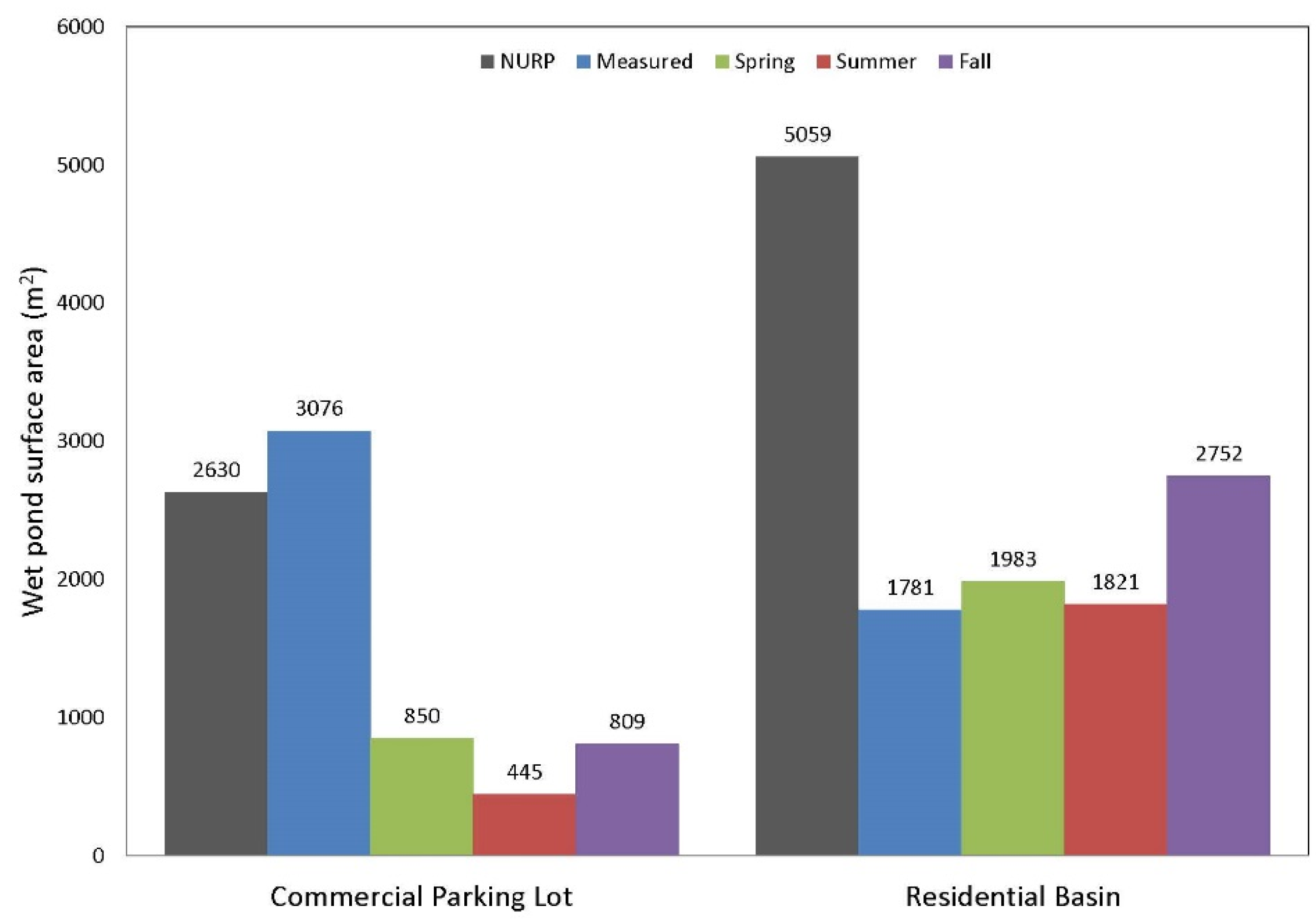
3.3. The Effect of Particle Size Distribution on Catch Basin Diameter

4. Discussion

5. Conclusions
Supplementary Files
Supplementary File 1Acknowledgments
Author Contributions
Conflicts of Interest
References
- Wisconsin State Legislature. NR 151: Runoff Management. In Wisconsin Administrative Code and Register 35.93; Wisconsin State Legislature: Madison, WI, USA, 2013; pp. 399–408. [Google Scholar]
- U.S. Environmental Protection Agency. Total Maximum Daily Load Program. Available online: http://water.epa.gov/lawsregs/lawsguidance/cwa/tmdl (accessed on 1 July 2015).
- Greb, S.R.; Bannerman, R.T. Influence of particle size on wet pond effectiveness. Water Environ. Res. 1997, 69, 1134–1138. [Google Scholar] [CrossRef]
- Minton, G. Stormwater Treatment: Biological, Chemical, and Engineering Principles, 3rd ed.; Sheridan Books: Schaumburg, IL, USA, 2011; p. 416. [Google Scholar]
- Selbig, W.R.; Bannerman, R.T. Characterizing the Distribution of Particles in Urban Stormwater Using Fixed-point Sample Collection Methods; Open-File Report 2011-1052; U.S. Geological Survey: Reston, VA, USA, 2011; p. 14.
- Selbig, W.R. Characterizing the distribution of particles in urban stormwater: Advancements through improved technology. Urban Water J. 2013, 12, 111–119. [Google Scholar] [CrossRef]
- U.S. Environmental Protection Agency. Results of the Nationwide Urban Runoff Program: Volume 1—Final Report. Available online: http://www.epa.gov/npdes/pubs/sw_nurp_vol_1_finalreport.pdf (accessed on 29 June 2015).
- Lin, H. How well do we know “particle size” in urban runoff pollution control? In Proceedings of the World Environmental and Water Resources Congress, Honolulu, HI, USA, 12–16 May 2008.
- Li, Y.; Lau, S.-L.; Kayhanian, M.; Stenstrom, M. Particle size distribution in highway runoff. J. Environ. Eng. 2005, 131, 1267–1276. [Google Scholar] [CrossRef]
- Piro, P.; Carbone, M.; Garofalo, G.; Sansalone, J. Size distribution of wet weather and dry weather particulate matter entrained in combined flows from an urbanizing sewershed. Water Air Soil Pollut. 2010, 206, 83–94. [Google Scholar] [CrossRef]
- Garofalo, G.; Carbone, M.; Piro, P. Sampling, testing and modeling particle size distribution in urban catch basins. Water Sci. Technol. 2014, 70, 1873–1879. [Google Scholar] [CrossRef] [PubMed]
- Ferriera, M.; Stenstrom, M.K. The importance of particle size characterization in stormwater runoff. Water Environ. Res. 2013, 85, 833–842. [Google Scholar] [CrossRef]
- Sansalone, J.J.; Kim, J-Y. Transport of particulate matter fractions in urban source area pavement surface runoff. J. Environ. Qual. 2008, 37, 1883–1893. [Google Scholar] [CrossRef] [PubMed]
- Clark, S.E.; Siu, C.Y.S. Measuring solids concentration in stormwater runoff: Comparison of analytical methods. Environ. Sci. Technol. 2008, 42, 511–516. [Google Scholar] [CrossRef] [PubMed]
- International Stormwater BMP Database. Available online: http://www.bmpdatabase.org/Docs/FAQ%20Background%20v1.pdf (accessed on 11 January 2013).
- Selbig, W.R.; Bannerman, R.T. Evaluation of Street Sweeping as a Stormwater-quality Management Tool in Three Residential Basins in Madison, Wisconsin; Scientific Investigations Report 2007-5156; U.S. Geological Survey: Reston, VA, USA, 2007; p. 103.
- Horowitz, A.J. The Use of Suspended Sediment and Associated Trace Elements in Water Quality Studies; International Association of Hydrological Sciences Press: Wallingford, UK, 1995; pp. 1–58. [Google Scholar]
- Burton, A.G.; Pitt, R. Stormwater Effects Handbook: A Toolbox for Watershed Managers, Scientists, and Engineers, 1st ed.; CRC Press: Boca Raton, FL, USA, 2002; pp. 451–453. [Google Scholar]
- Selbig, W.R.; Fienen, M.N. Regression modeling of particle size distributions in urban stormwater: Advancements through improved sample collection methods. J. Environ. Eng. 2012, 138, 1186–1193. [Google Scholar] [CrossRef]
- Driscoll, E.D. Detention and retention controls for urban stormwater. In Urban Runoff Quality—Impact and Quality Enhancement Technology, Proceedings of the Engineering Foundation Conference, Heinniker, NH, USA, 23–27 June 1986; Urbonas, B., Roesner, L.A., Eds.; American Society of Civil Engineers: New York, NY, USA, 1986; pp. 145–163. [Google Scholar]
- Selbig, W.R. Concentrations of Polycyclic Aromatic Hydrocarbons (PAHs) in Urban Stormwater, Madison, Wisconsin 2005-08; Open-File Report 2009-1077; U.S. Geological Survey: Reston, VA, USA, 2009; p. 45.
- U.S. Environmental Protection Agency. Methodology for Analysis of Detention Basins for Control of Urban Runoff Quality; EPA A440/5-87-001; U.S. Environmental Protection Agency: Washington, DC, USA, 1985; p. 72.
- Pitt, R.; University of Alabama-Birmingham, Birmingham, AL, USA. Personal communication, 2015.
- Selbig, W.R.; Bannerman, R.T. Development of a Depth-Integrated Sample Arm (DISA) to reduce solids stratification bias in stormwater sampling. Water Environ. Res. 2011, 83, 347–357. [Google Scholar] [CrossRef] [PubMed]
- Smith, K.P. Effectiveness of Three Best Management Practices for Highway-Runoff Quality along the Southeast Expressway, Boston, Massachusetts; Water-Resources Investigations Report 02-4059; U.S. Geological Survey: Reston, VA, USA, 2002; p. 62.
- Fowler, G.D.; Roseen, R.M.; Ballestero, T.P.; Guo, Q.; Houle, J. Sediment monitoring bias by autosampler in comparison with whole volume sampling for parking lot runoff. In Great Rivers, Proceedings of the World Environmental and Water Resources Congress, Kansas City, MO, USA, 17–21 May 2009; p. 9.
- Selbig, W.R.; Cox, A.; Bannerman, R.T. Verification of a depth-integrated sample arm as a means to reduce solids stratification bias in urban stormwater sampling. J. Environ. Monit. 2012, 14, 1137–1143. [Google Scholar] [CrossRef] [PubMed]
- Helsel, D.R.; Hirsch, R.M. Statistical methods in water resources. In Techniques in Water Resources Investigations; U.S. Geological Survey: Reston, VA, USA, 2002. [Google Scholar]
- Rosin, P.; Rammler, E. The laws governing the fineness of powdered coal. J. Inst. Fuel 1933, 7, 29–36. [Google Scholar]
- Weibull, W. A statistical theory of the strength of materials. In Ingeniörs Vetenskaps Akademiens; Swedish Institute of Engineering Research: Stockholm, Sweden, 1939; p. 151. (In German) [Google Scholar]
- Doherty, J. PEST, Model-independent Parameter Estimation—User Manual, 5th ed.; Watermark Numerical Computing: Brisbane, Australia, 2010. [Google Scholar]
- Pitt, R.; Vorhees, J. SLAMM, the Source Loading and Management Model. In Wet-weather Flow in the Urban Watershed; Field, R., Sullivan, D., Eds.; CRC Press: Boca Raton, USA, 2002; pp. 103–139. [Google Scholar]
- Wisconsin Department of Natural Resources. Conservation Practice 1001: Wet Detention Ponds. Available online: http://dnr.wi.gov/topic/stormwater/documents/WetPondStd1001.pdf (accessed on 23 July 2015).
- Pitt, R. The Design, Use, and Evaluation of Wet Detention Ponds for Stormwater Quality Management: Using WinDETPOND. 2003. Available online: http://unix.eng.ua.edu/~rpitt/Publications/StormwaterTreatability/Detention ponds with WinDETPOND.pdf (accessed on 31 August 2015).
- U.S. Geological Survey. Description of Wisconsin WinSLAMM Parameter Files. Available online: http://wi.water.usgs.gov/slamm/slamm_parameter_descriptions.htm#ran (accessed on 24 July 2015).
- Wisconsin Department of Natural Resources. Conservation Practice 1006: Method for Predicting the Efficiency of Proprietary Storm Water Sedimentation Devices. Available online: http://dnr.wi.gov/topic/stormwater/documents/prop_devices_standard_v2_040909.pdf (accessed on 1 September 2015).
- Bannerman, R. Verification of a method for sizing all proprietary single chamber treatment devices with settling as a unit process. In Proceedings of the StormCon05, Orlando, FL, USA, 18–21 July 2005.
- Brezonik, P.L.; Stadelmann, T.H. Analysis and predictive models of stormwater runoff volumes, loads, and pollutant concentrations from watershed in the Twin Cities metropolitan area, Minnesota, USA. Water Res. 2002, 36, 1743–1757. [Google Scholar] [CrossRef]
- Horwatich, J.A.; Bannerman, R.T. Parking Lot Runoff Quality and Treatment Efficiencies of a Hydrodynamic-settling Device in Madison, Wisconsin, 2005-6; Scientific Investigations Report 2011-5145; U.S. Geological Survey: Reston, VA, USA, 2012; pp. 1–35.
- Granato, G.E. Stochastic empirical loading and dilution model (SELDM) version 1.0.0. In Techniques and Methods 4-C3 [CD–ROM]; U.S. Geological Survey: Reston, VA, USA, 2013; p. 112. [Google Scholar]
© 2016 by the authors; licensee MDPI, Basel, Switzerland. This article is an open access article distributed under the terms and conditions of the Creative Commons by Attribution (CC-BY) license (http://creativecommons.org/licenses/by/4.0/).
Share and Cite
Selbig, W.R.; Fienen, M.N.; Horwatich, J.A.; Bannerman, R.T. The Effect of Particle Size Distribution on the Design of Urban Stormwater Control Measures. Water 2016, 8, 17. https://doi.org/10.3390/w8010017
Selbig WR, Fienen MN, Horwatich JA, Bannerman RT. The Effect of Particle Size Distribution on the Design of Urban Stormwater Control Measures. Water. 2016; 8(1):17. https://doi.org/10.3390/w8010017
Chicago/Turabian StyleSelbig, Willliam R., Michael N. Fienen, Judy A. Horwatich, and Roger T. Bannerman. 2016. "The Effect of Particle Size Distribution on the Design of Urban Stormwater Control Measures" Water 8, no. 1: 17. https://doi.org/10.3390/w8010017





